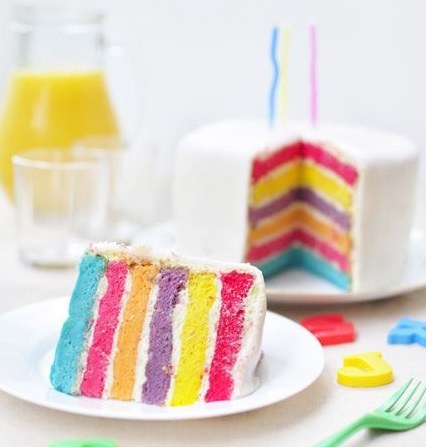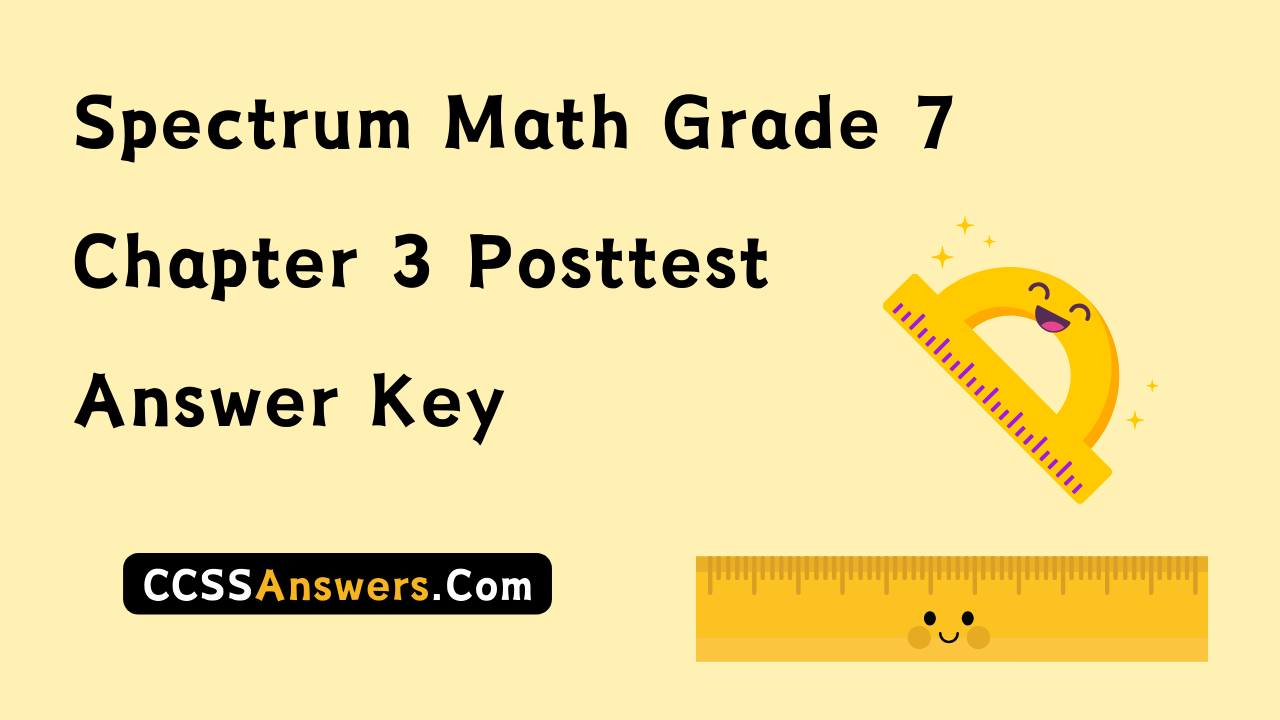This handy Spectrum Math Grade 7 Answer Key Chapter 3 Posttest provides detailed answers for the workbook questions
Spectrum Math Grade 7 Chapter 3 Posttest Answers Key
Check What You Learned
Expressions, Equations, and Inequalities
Rewrite each expression using the property indicated.
Question 1.
a. commutative: 4 × 5
______________
Answer: 5 × 4
According to the commutative property of multiplication, changing the order of the numbers we are multiplying does not change the product. If there are two numbers, x and y, the commutative property of multiplication implies that x × y = y × x.
4 × 5 = 5 × 4
20 = 20
b. distributive: 6 × (8 – 5)
________________
Answer: (6 × 8) – (6 × 5)
The distributive property states that multiplying the sum of two or more addends by a number yields the same outcome as multiplying each addend separately by the number and combining the resulting products. a × (b – c) = (a × b) – (a × c) is the rule for distributive property.
6 × (8 – 5) = (6 × 8) – (6 × 5)
18 =18
Question 2.
a. associative: (12 × 7) × 8
_____________
Answer: 12 × (7 × 8)
According to the associative principle of addition, when adding three integers, the outcome will always be the same regardless of how the numbers are grouped. If there are three numbers, x, y and z, the associative property of addition implies that x × (y × z) = (x × y) × z. The grouping of addends does not change the sum.
(12 × 7) × 8 = 12 × (7 × 8)
672 = 672
b. associative: (3 + 4) + 5
_____________
Answer:
According to the associative principle of addition, when adding three integers, the outcome will always be the same regardless of how the numbers are grouped. If there are three numbers, x, y and z, the associative property of addition implies that x + (y + z) = (x + y) + z. The grouping of addends does not change the sum.
(3 + 4) + 5 = 3 + (4 + 5)
12 =12
Question 3.
a. identity: 32 × 1
___________
Answer:
According to the identity property of multiplication, if a number is multiplied by 1 (one), the result will be the original number. This property is applied when numbers are multiplied by 1. If there is a number, x then the identity property implies that x × 1 = x.
32 × 1 = 32
b. zero: 0 × 4
_______________
Answer: 0
According to the zero property of multiplication, if a number is multiplied by 0 (zero), the result will be zero. This property is applied when numbers are multiplied by 0. If there is a number, x then the identity property implies that x × 0 = 0.
0 × 4 = 0
Write each phrase as an expression or equation.
Question 4.
a. seven less than a number
______________
Answer: 7 < x
Let x be the number.
The expression for ‘seven less than a number’ can be given as 7 < x
b. eight more than a number
______________
Answer: 8 > x
Let x be the number.
The expression for ‘eight more than a number’ can be given as 8 > x
Question 5.
a. the product of six and a number
______________
Answer: 6 × x
Let x be the number.
The expression for ‘the product of six and a number’ can be given as 6 × x
b. a number divided by twelve
______________
Answer: x ÷ 12
Let x be the number.
The expression for ‘a number divided by twelve’ can be given as x ÷ 12
Question 6.
a. the product of 4 and a number is 16
______________
Answer:
Let x be the number.
The equation for ‘the product of 4 and a number is 16’ can be given as 4 × x = 16
b. nine more than a number is 11
______________
Answer: 9 > x = 11
Let x be the number.
The equation for ‘nine more than a number is 11’ can be given as 9 > x = 11
Question 7.
a. three less than a number is twenty
______________
Answer: 3 < x = 20
Let x be the number.
The equation for ‘three less than a number is twenty’ can be given as 3 < x = 20
b. twenty-five divided by a number is five
______________
Answer: 25 ÷ x = 5
Let x be the number.
The equation for ’twenty-five divided by a number is five′ can be given as 25 ÷ x = 5
Question 8.
a. a number divided by 10 is 11
______________
Answer: x ÷ 10 = 11
Let x be the number.
The equation for ’a number divided by 10 is 11′ can be given as x ÷ 10 = 11
b. the product of 5 and a number is 25
______________
Answer: 5 × x = 25
Let x be the number.
The equation for ‘the product of 5 and a number is 25’ can be given as 5 × x = 25
Question 9.
a. 1.2 more than a number
______________
Answer: 1.2 > x
Let x be the number.
The expression for ‘1.2 more than a number’ can be given as 1.2 > x
b. thirty-two divided by a number is 16
______________
Answer: 32 ÷ x = 16
Let x be the number.
The equation for ’thirty-two divided by a number is 16′ can be given as 32 ÷ x = 16
Question 10.
a. fifteen less than a number
______________
Answer: 15 < x
Let x be the number.
The expression for ‘fifteen less than a number’ can be given as 15 < x
b. 14 divided by a number is two
______________
Answer: 14 ÷ x = 2
Let x be the number.
The equation for ’14 divided by a number is two′ can be given as 14 ÷ x = 2
Solve each problem by creating an equation or inequality.
Question 11.
Yael bought two magazines for $5 and some erasers that cost $ 1.00 each. He could only spend $25. How many erasers could he buy?
Let e represent the number of erasers he was able to buy.

Equation or Inequality: ____________
Yael can buy _____ erasers.
Answer:
Inequality: 2 × $5 + e × $ 1.00 ≤ $25
Yael can buy 15 erasers.
Yael bought two magazines for $5 and some erasers that cost $ 1.00 each.
He could only spend $25.
Let e represent the number of erasers he was able to buy.
Inequality: 2 × $5 + e × $ 1.00 ≤ $25
10 + e ≤ 25
e ≤ 25 -10
e ≤ 15
Therefore, Yael can buy 15 erasers.
Question 12.
The sum of three consecutive numbers Is 75. What is the smallest of these numbers?
Let n represent the smallest number.
Equation or Inequality: ___________
_____ is the smallest number in the set.
Answer:
Equation: x + x+1+ x+2 = 75
24 is the smallest number in the set.
The sum of three consecutive numbers Is 75.
Let the numbers be x, x+1 and x+2.
Then the sum is : Equation: x + x+1+ x+2 = 75
3x + 3 = 75
3x = 75 – 3 = 72
x = 72 ÷ 3
x = 24
Therefore, The smallest of these numbers is 24
Question 13.
Summer won 40 super bouncy balls playing Skee Ball at her school’s fall festival. Later, she gave 3 to each of her friends. She only has 7 remaining. How many friends does she have?

Let f represent the number of friends.
Equation or Inequality: ______________
Summer shared with _____ friends.
Answer:
Equation: 40 – 3 × f = 7
Summer shared with 11 friends.
Summer won 40 super bouncy balls playing Skee Ball at her school’s fall festival.
Later, she gave 3 to each of her friends.
She only has 7 remaining.
Let f represent the number of friends.
Number of friends Summer has = 40 – 3 × f = 7
40 – 3f = 7
40 – 3f – 7 = 0
-3f + 33 = 0
-3f = -33
3f = 33
f = 33 ÷ 3
f = 11
Therefore, Summer shared with 11 friends.
Question 14.
Mrs. Watson had some candy to give to her students. She first took ten pieces for herself and then evenly divided the rest among her students. Each student received two pieces. If she started with 50 pieces of candy, how many students does
she teach?
Let s represent the number of students.
Equation or Inequality: ________________
Mrs. Watson teaches ______ students.
Answer:
Equation: 10 + 2 × s = 50
Mrs. Watson teaches 20 students.
Mrs. Watson had some candy to give to her students.
She first took ten pieces for herself and then evenly divided the rest among her students. Each student received two pieces.
She started with 50 pieces of candy.
Let s represent the number of students.
Therefore, number of students = 10 + 2 × s = 50
10 + 2s = 50
2s = 50 -10
2s = 40
s = 40 ÷ 2
s = 20
so, Mrs. Watson teaches 20 students.
Question 15.
The Cooking Club made some cakes to sell at a baseball game to raise money for the school library. The cafeteria contributed 5 cakes to the sale. Each cake was then cut into 10 pieces and sold. There were a total of 80 pieces to sell. How many cakes did the club make?

Let c represent the number of cakes.
Equation or Inequality: ____________
The club made _____ cakes.
Answer:
Equation: 50 + c × 10 = 80
The club made 3 cakes.
The Cooking Club made some cakes to sell at a baseball game to raise money for the school library.
The cafeteria contributed 5 cakes to the sale.
Each cake was then cut into 10 pieces and sold.
Therefore, total pieces contributed by cafeteria = 5 × 10 = 50 pieces
There were a total of 80 pieces to sell.
Let c represent the number of cakes.
Number of cakes made by club = 50 + c × 10 = 80
50 + 10c = 80
10c = 80 – 50
10c = 30
c = 30 ÷ 10
c = 3
So, The cooking club made 3 cakes.
